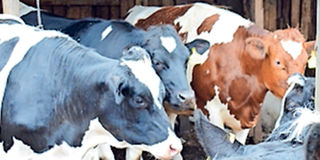How weather affects your cow’s milk

Dairy cattle in a farm. Feeding balanced rations that meet the chemical and physical needs of the cow is imperative for their good milk production. PHOTO | CAROLINE WAMBUI | NMG
What you need to know:
- Farmers should, therefore, ensure the feeds they offer their cows are balanced, that is, have energy, protein, minerals and vitamins.
- Experts explain that when there is less fodder, the animals don’t get enough fibre, and with less fibre, there is less chewing of the cud and less secretion of butyric acid, which is responsible for butter fat leading to low density milk.
- Overfeeding concentrate, on the other hand, may reduce milk fat content and increase milk protein, though feeding of excess dietary protein doesn’t increase milk protein as most of the excess protein is excreted.
- Disease and especially mastitis have also been known to reduce fat and casein and increase whey content of milk.
Milk composition is economically important to the producers and processors and nutritionally vital to the consumers.
A rising trend of health conscious consumers and the introduction of milk pricing system based on quality has compelled processors to focus on the milk component rather quantity.
Paul Mambo, a dairy consultant with SNV Kenya, says that many factors affect and alter the milk components among them nutrition, genetics and environment, season, age of the cow, stage of lactation, level of production and diseases.
“The major milk components are water, fat, protein, lactose and minerals. Nutrition or the feeding management practices in a dairy farm can have a major impact on the levels of milk fat and protein concentration. Fat concentration is sensitive to dietary changes,” he says.
According to him, milk fat and protein component tend to be high during the rainy season and lowest during the dry seasons, variations that are attributed to changes in both the type of feed and climatic conditions.
“When cows go out for pasture in the dry periods, the milk fat is reduced and it is at this time when some farmers cannot afford quality fodder and quite often turn to rice and wheat straws,” says Mambo.
Farmers should, therefore, ensure the feeds they offer their cows are balanced, that is, have energy, protein, minerals and vitamins.
Mambo further says that feeds like dry maize stovers have low nutritional value and are only meant to pacify hunger as they add no value in milk production.
FEEDING BALANCED RATIONS
“With such feeds, the animals only spend plenty of time, up to 72 hours digesting it thus reducing the milk fat,” he explains. During the dry season, the quality of milk can be defective as some farmers opt to supplement the deficient fodder with concentrates in form of dairy meal as to attain the same milk yield.
Experts explain that when there is less fodder, the animals don’t get enough fibre, and with less fibre, there is less chewing of the cud and less secretion of butyric acid, which is responsible for butter fat leading to low density milk.
“What follows is milk that gets rejected at the co-operatives. When fodder is substituted with dairy meal, more propionic acid than butyric acid is produced translating to waterier milk,” he says.
Overfeeding concentrate, on the other hand, may reduce milk fat content and increase milk protein, though feeding of excess dietary protein doesn’t increase milk protein as most of the excess protein is excreted.
Hot weather season also has negative effect on animals as it decreases saliva production, which in turn affects the buttering capacity of the rumen and with a reduced ruminal pH, milk fat may be reduced.
Disease and especially mastitis have also been known to reduce fat and casein and increase whey content of milk. Milk antibiotic residue also affect the composition of milk as some farmers treat their cows and don’t observe the withdrawal period of the antibiotics.
Benald Kinoti, an extension officer in Meru County, says that farmers also need to understand the breed they are rearing as Ayrshires and Friesians will have quite different type of milk depending on the components.
Felix Opinya, a dairy specialist from Egerton University, says farmers should adopt feeding and other management strategies that best enhance good health and functioning of the rumen.
“Feeding balanced rations that meet the chemical and physical needs of the cow is imperative for good milk production,” he says





